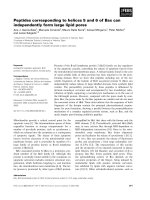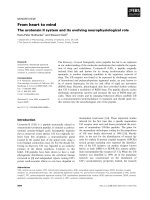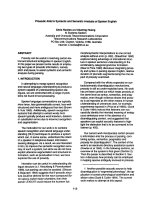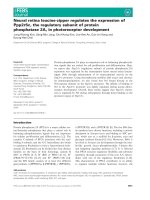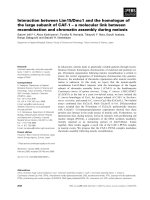Báo cáo khoa học: From meiosis to postmeiotic events: The secrets of histone disappearance potx
Bạn đang xem bản rút gọn của tài liệu. Xem và tải ngay bản đầy đủ của tài liệu tại đây (176.52 KB, 6 trang )
MINIREVIEW
From meiosis to postmeiotic events: The secrets of
histone disappearance
Jonathan Gaucher, Nicolas Reynoird, Emilie Montellier, Fayc¸al Boussouar, Sophie Rousseaux and
Saadi Khochbin
INSERM, U823; Universite
´
Joseph Fourier, Institut Albert Bonniot, Grenoble, France
Introduction
One of the last completely unknown biological pro-
cesses is the molecular basis of postmeiotic haploid
genome reprogramming. Our lack of knowledge of this
phenomenon includes sporulation in lower eukaryotes
and pollen formation in plants, as well as spermato-
genesis, all directing a large-scale genome compaction.
Simple and fundamental questions regarding the
molecular basis of genome compaction and reorganiza-
tion are completely unanswered. Additional questions
concern the assembly of new DNA-packaging proteins,
including specific histone variants and nonhistone
small basic proteins such as transition proteins (TPs)
and protamines (Prms) [1–4].
For about 30 years, these questions have inspired
various types of investigation, without providing any
insights into the molecular mechanisms involved.
These studies have, however, suggested that an essen-
tial element in histone replacement could be the very
nature of the testis-specific genome-packaging proteins
themselves. Indeed, in various species, histones are
replaced by small basic structural DNA-packaging
proteins [5]. In mammals, TPs are the first nonhistone
DNA-packaging proteins to appear in large amounts
and replace histones, which are in turn replaced by
Prms [1,6]. This is, however, not a general rule,
because, in some species of fish, birds and inverte-
brates, histones may be replaced directly by Prms and
Prm-like proteins [7,8]. Another important aspect of
the genome organization that occurs during male
germ cell differentiation is the replacement of canoni-
cal histones by a variety of histone variants, which
takes place extensively in meiotic and postmeiotic
cells before the replacement of almost all of the
histones.
Keywords
acetylation; chromatin; epigenetics; histone
variants; nucleosomes; protamines;
protease; sperm; transition proteins
Correspondence
S. Khochbin, INSERM, U823, Universite
´
Joseph Fourier, Institut Albert Bonniot,
Grenoble, F-38700 France
Fax: +33 4 76 54 95 95
Tel: +33 4 76 54 95 83
E-mail:
(Received 20 July 2009, accepted 20
October 2009)
doi:10.1111/j.1742-4658.2009.07504.x
One of the most obscure phenomena in modern biology is the near
genome-wide displacement of histones that occurs during the postmeiotic
phases of spermatogenesis in many species. Here we review the literature to
show that, during spermatogenic differentiation, three major molecular
mechanisms come together to ‘prepare’ the nucleosomes for facilitated
disassembly and histone removal.
Abbreviations
Prm, protamine; TP, transition protein.
FEBS Journal 277 (2010) 599–604 ª 2009 The Authors Journal compilation ª 2009 FEBS 599
Although no clear mechanisms have been proposed
for histone replacement, analysis of the literature
suggests that three general mechanisms act in combina-
tion to destabilize the nucleosomes and replace the
histones. These are: (a) large-scale incorporation of
histone variants, creating less stable nucleosomes; (b)
genome-wide histone hyperacetylation; and (c) compe-
tition for DNA binding with very basic DNA-interact-
ing nonhistone proteins such as TPs and Prms (Fig. 1).
Here, we review the literature on these three aspects,
to highlight our lack of knowledge about the mecha-
nisms controlling the shift from a nucleosome-based
genome organization to a genome packed via nucleo-
protamines.
Destabilization of the nucleosomes by
histone variants
In different species, many of the core or linker histone
variant genes are exclusively expressed in male germ
cells. In mice and humans, almost all of the H2A,
H2B, H3 and H1 variants are expressed in testis.
Among them, some are highly and ⁄ or exclusively
expressed in spermatogenic cells, and, interestingly, the
only known H2B variants are testis-specific (Table 1).
Some of these H2A and H2B variants have been sub-
jected to structural and functional analyses, and all of
these studies point to the nucleosomes containing these
variants as being significantly less stable than those
composed of canonical histones.
The only testis-specific H2B variants, hTSH2B ⁄
TH2B and H2BFWT, that have been studied in a nucle-
osome showed a marked ability to induce nucleosome
instability when associated with somatic-type histones
[9,10]. Moreover, recently, five new testis-specific H2A
and H2B variants have been identified in the mouse,
and named H2AL1, H2AL2, H2AL3, H2BL1, and
H2BL2 [11]. Here again, investigation of nucleosomes
composed of some of these variants showed that
H2AL2 ⁄ TH2B-containing nucleosomes are less stable
than those containing H2A⁄ H2B. These particular
studies also supported the idea that TH2B-containing
nucleosomes could be preferential sites for H2AL1-L2
8 16 Steps
Histones
Hyperacetylation
12
Transition proteins
Transitional states Nucleoprotamines
Nucleosomes
Protamines
Round spermatid
Spermatozoon
Open chromatin
&
unstable nucleosomes
Hyperacetylation
Histone
replacement
by basic proteins
Histone variants
TPs - Prms
Histone proteolysis
Fig. 1. The secrets of histone disappearance in elongating spermatids. (A) Extensive incorporation of histone variants and global histone
hyperacetylation prior to their replacement create open chromatin domains containing unstable nucleosomes. The presence of highly basic
small DNA-packaging proteins such as TPs could facilitate histone eviction and a shift from a nucleosomal-based genome organization to
nonhistone protein-based DNA packaging.
Table 1. The list of testis-specific histone variants in the mouse
and human. Homologous proteins in the mouse and human
[1,11,15] are indicated by an asterisk. +, H2ABbd is an ortholog of
mouse H2AL1 ⁄ L2 [12] and, accordingly, is almost exclusively
expressed in testis (our unpublished data).
Histone variants Mouse Human
H2A H2Al 1* H2A.Bbd*+
H2Al 2*
H2Al 3
H2B H2Bl 1 hTSH2B*
H2Bl 2 H2BFWT
TH2B*
H3 H3t H3T
H1 H1t H1T
H1t2 H1T2
Hils1 HILS1
The secrets of histone disappearance J. Gaucher et al.
600 FEBS Journal 277 (2010) 599–604 ª 2009 The Authors Journal compilation ª 2009 FEBS
incorporation, as H2AL1 and H2AL2 dimerize better
with TH2B than with H2B [11].
The incorporation of the human homolog of
H2AL2 [12], H2A.Bbd, has also been shown to signifi-
cantly affect nucleosome stability [13].
It is also of note that, even in the case of somatic-
type histone variants expressed in spermatogenic cells,
there is a high probability of them combining to create
peculiar nucleosomes bearing various combinations of
histones, such as H3.3 and H2A.Z, that induce nucleo-
some instability [3,14].
Furthermore, the testis-specific linker histone, H1t,
has also been shown to be less efficient in compacting
chromatin than other H1 subtypes, and has less affin-
ity not only for nucleosomal DNA but also for free
DNA [15].
It is therefore very tempting to hypothesize that
waves of histone variants with the capacity to open
chromatin and to form unstable nucleosomes are
synthesized and incorporated to create chromatin
domains, which then constitute preferential targets for
nucleosome disassembly and histone displacement.
Facilitated histone displacement by
massive chromatin acetylation
Histone hyperacetylation has long been observed in
elongating spermatids in many species [1]. In the
mouse, histone hyperacetylation starts while a general
transcriptional shutdown is observed [16]. Therefore,
elongating spermatids heavily acetylate their histones in
the total absence of DNA replication and transcription.
TP1 and TP2 are detected first, and the acetylation sig-
nal gradually disappears during the course of histone
replacement [17]. This chromatin acetylation therefore
seems to be tightly linked to histone replacement.
Additional arguments in favor of acetylation-dependent
histone displacement come from studies showing that
histones remain underacetylated in species where they
remain present all through spermiogenesis such as
winter flounder and carp [18,19]. Furthermore, the
anterocaudal disappearance of the acetylation signal
correlates very well with an anterior-to-posterior
direction of genome compaction [17].
Additionally, several in vitro and biochemical studies
support the idea that nucleosomes containing hyper-
acetylated histones are more prone to displacement by
highly basic proteins such as Prms [20–22]. These
results fit well with later investigations showing that
general and site-specific histone acetylation can affect
the higher-order structure of chromatin and nucleo-
some properties [23–26] and facilitate the exchange of
histones [27].
Although these acetylation-dependent changes in
chromatin properties convincingly point to histone
hyperacetylation as a critical element in histone
removal, they do not indicate how this removal of acety-
lated histones is performed. Consideration of the
‘histone code’ and of the corresponding ‘reading factors’
has opened new ways to tackle the in vivo mechanistic
issue. Indeed, because of the recognition of acetylated
histones by bromodomains, which are structural mod-
ules of 110 amino acids capable of interacting with acet-
ylated lysines [28], factors containing these domains
appear to be the first-choice candidates for interaction
with acetylated histones in elongating spermatids and
mediatation of their removal. This reasoning led us to
investigate the function of a testis-specific double-brom-
odomain factor, Brdt, which has the ability to interact
with acetylated chromatin and induce its global reorga-
nization [29]. These investigations support a critical role
for Brdt in mediating chromatin acetylation-dependent
events during spermiogenesis. This hypothesis has
received additional support from the demonstration of
its indispensable action in elongating⁄ condensing sper-
matids [30]. The molecular characterization of this par-
ticular factor, as well as of other bromodomain-
containing proteins expressed in elongating spermatids,
should shed light on the nature of the underlying mecha-
nisms [31].
Direct histone displacement by
nonhistone DNA-packaging basic
proteins
The chromatin opening and enhanced histone
exchange induced by global histone hyperacetylation,
as well as the nucleosome instability resulting from the
incorporation of histone variants, explain why in vitro
histone replacement by small testis-specific basic pro-
teins is facilitated [20–22]. These considerations point
to TPs in mammals as sufficient to displace the
histones. The generation of mice lacking either TP1 or
TP2 did not, however, bring an answer, because of
considerable functional redundancy between the two
proteins [32]. Analysis of mice lacking both TPs gave
surprising results. In these mice, histone displacement
was found to occur normally despite the total absence
of TPs. These results show that, as opposed to the
prediction, TPs do not play a role in the removal of
histones. A detailed analysis showed, however, that
when histone removal is complete, genome compaction
does not occur normally along the anterocaudal axis,
but that, instead, focal DNA condensations are
observed [16]. Interestingly, a focal chromatin conden-
sation has been observed in several species where a
J. Gaucher et al. The secrets of histone disappearance
FEBS Journal 277 (2010) 599–604 ª 2009 The Authors Journal compilation ª 2009 FEBS 601
direct histone-to-protamine replacement takes place
without any other intermediary states [8,33]. In sper-
matids lacking TPs, where focal condensation units
form upon histone removal and enlarge during later
stages, the situation is somehow similar to that
observed in these organisms [16]. It is therefore highly
probable that, in the absence of TPs, direct replace-
ment of histones by Prms could take place, because
the latter would be the winners of the competition for
DNA binding.
The generation of mice without TPs did not, there-
fore, allow conclusions to be drawn concerning the
role of small basic DNA-packaging proteins in histone
displacement. In order to test this hypothesis, mice
lacking both TPs and Prms would be required. Indeed,
to understand the basis of histone replacement, it
would be critical to know whether the competition for
DNA binding plays a direct role in histone displace-
ment. However, these mice would be difficult to
obtain, as Prm haploinsufficency results in male steril-
ity [34], and therefore Prm conditional mutants would
need to be generated, and then crossed with mice lack-
ing TPs. The role of Prms in histone removal could,
however, be investigated in Drosophila, where sper-
matogenesis is also associated with histone hyperacety-
lation and histone replacement by two Prm-like
proteins [35]. In this organism, the absence of both
Prm-encoding genes did not affect histone removal.
Here again, it was not possible to draw conclusions
about the role of small basic proteins in histone dis-
placement, as a TP-like protein was discovered that is
synthesized during histone removal, and the above-
mentioned work did not consider the impact of the
inactivation of the gene encoding this protein on
histone replacement [35].
Histone replacement through
proteolysis
The possibility also exists that histones are degraded in
place by some specific proteases before or during TP
assembly. Indeed, early studies suggested that sper-
matogenic cells could have specific histone proteases
that may account for the disappearance of histones in
spermatids.
Marushige et al. [20] were the first to propose that
histone hyperacetylation combined with the action of
chromosomally associated proteases could explain the
disappearance of hyperacetylated histones in spermat-
ids. Other reports followed, among which the most
interesting was that of Faulkner et al., [36] who found
that a chromatin-associated protease is present in
micrococcal nuclease-solubilized chromatin from
mouse seminiferous tubules. The protease was associ-
ated with dinucleosomes or oligonucleosomes, but not
with mononucleosomes, and its activity appeared in a
stage-specific manner, as it was not present in sper-
matogenic cells up to 3–4 weeks after birth [36], sug-
gesting that it affected late postmeiotic cells. Here also,
the authors proposed a role for this protease in histone
displacement. Although all of these findings need to be
taken with caution, mostly because of the presence of
many proteases associated with the acrosome [37], the
possibility of direct degradation of histones by a chro-
matin-bound protease should be seriously considered.
There are also some hints on the possibility of histone
degradation through the ubiquitin–proteasome system.
Indeed, an early report described the presence of mono-
ubiquitinated and polyubiquitinated H3, H3t and H2B
in elongating rat spermatids, where histones are
removed [38]. More interestingly, later on, the group of
Wing [39] identified a ubiquitin ligase, named E3
Histone
,
capable of ubiquitinating all histones in vitro. Although
the enzyme was found to be expressed in many tissues
besides testis, its preferred E2 is UBC4, which has a
testis-specific isoform, UBC4-testis, expressed mainly in
round and elongating spermatids [39]. However, a
detailed study of E3
Histone
expression did not show its
presence in spermatids, a result that invites caution con-
cerning its involvement in histone replacement [40].
Involvement of the ubiquitin–proteasome system in his-
tone removal received better support in Drosophila.
Indeed, the inactivation of a testis-specific proteasome
core particle subunit, Prosa6T, leads to spermiogenesis
defects affecting spermatids during the elongation
process. A detailed analysis of flies expressing a green
fluorescent protein-tagged His2AvD transgene showed
that, under these conditions, histone removal is delayed
but Prm incorporation and histone disappearance
finally take place [41]. This report provides the first seri-
ous indication of the role of histone degradation and,
more specifically, the involvement of the ubiquitin–
proteasome system in histone removal.
Concluding remarks
This minireview highlights the fact that, although the
question of the mechanisms controlling genome-wide
histone replacement has been raised many times by
many investigators, very few studies have specifically
aimed at the identification of the principal actors.
Analysis of the literature allows us to suggest a work-
ing model based on three distinct events that occur
long before histone replacement itself but prepare
chromatin for these dramatic transitions. It is of note
that the findings of many studies converge to show the
The secrets of histone disappearance J. Gaucher et al.
602 FEBS Journal 277 (2010) 599–604 ª 2009 The Authors Journal compilation ª 2009 FEBS
occurrence of events known to destabilize chromatin
higher-order structures and the nucleosomes them-
selves during stages preceding the synthesis and incor-
poration of small basic DNA-packaging proteins.
However, almost nothing is known of the actual
molecular machinery involved in histone replacement.
To better tackle this issue, one has to know whether
histones are evicted through competition with TPs and
Prms, or degraded on chromatin prior to the assembly
of these proteins. There is also a strong possibility that
before or during their replacement, histones become
degraded by chromatin-bound proteases or the ubiqu-
itin–proteasome system. It is also important to deter-
mine whether histone proteolysis concerns nucleosomal
histones or histones released after nucleosome disas-
sembly. Further dedicated and specific research is
needed to unravel one of the important mysteries of
modern biology.
Acknowledgements
The work in SK laboratory is supported by the ANR
blanche ‘‘EpiSperm’’ and ‘‘Empreinte’’ and INCa-
DHOS research programs.
References
1 Govin J, Caron C, Lestrat C, Rousseaux S & Khochbin
S (2004) The role of histones in chromatin remodelling
during mammalian spermiogenesis. Eur J Biochem 271,
3459–3469.
2 Rousseaux S, Caron C, Govin J, Lestrat C, Faure AK
& Khochbin S (2005) Establishment of male-specific
epigenetic information. Gene 345, 139–153.
3 Boussouar F, Rousseaux S & Khochbin S (2008) A new
insight into male genome reprogramming by histone
variants and histone code. Cell Cycle 7, 3499–3502.
4 Govin J & Berger SL (2009) Genome reprogramming
during sporulation. Int J Dev Biol 53, 425–432.
5 Ausio J, Eirin-Lopez JM & Frehlick LJ (2007)
Evolution of vertebrate chromosomal sperm proteins:
implications for fertility and sperm competition. Soc
Reprod Fertil Suppl 65, 63–79.
6 Wouters-Tyrou D, Martinage A, Chevaillier P &
Sautiere P (1998) Nuclear basic proteins in
spermiogenesis. Biochimie 80, 117–128.
7 Oliva R & Dixon GH (1991) Vertebrate protamine
genes and the histone-to-protamine replacement
reaction. Prog Nucleic Acid Res Mol Biol 40,
25–94.
8 Kurtz K, Martinez-Soler F, Ausio J & Chiva M (2007)
Acetylation of histone H4 in complex structural
transitions of spermiogenic chromatin. J Cell Biochem
102, 1432–1441.
9 Li A, Maffey AH, Abbott WD, Conde e Silva N,
Prunell A, Siino J, Churikov D, Zalensky AO & Ausio
J (2005) Characterization of nucleosomes consisting of
the human testis ⁄ sperm-specific histone H2B variant
(hTSH2B). Biochemistry 44, 2529–2535.
10 Boulard M, Gautier T, Mbele GO, Gerson V, Hamiche
A, Angelov D, Bouvet P & Dimitrov S (2006) The NH2
tail of the novel histone variant H2BFWT exhibits
properties distinct from conventional H2B with respect
to the assembly of mitotic chromosomes. Mol Cell Biol
26, 1518–1526.
11 Govin J, Escoffier E, Rousseaux S, Kuhn L, Ferro M,
Thevenon J, Catena R, Davidson I, Garin J, Khochbin
S et al. (2007) Pericentric heterochromatin reprogram-
ming by new histone variants during mouse spermio-
genesis. J Cell Biol 176, 283–294.
12 Syed SH, Boulard M, Shukla MS, Gautier T, Travers
A, Bednar J, Faivre-Moskalenko C, Dimitrov S &
Angelov D (2009) The incorporation of the novel his-
tone variant H2AL2 confers unusual structural and
functional properties of the nucleosome. Nucleic Acids
Res 37, 4684–4695.
13 Gonzalez-Romero R, Mendez J, Ausio J & Eirin-Lopez
JM (2008) Quickly evolving histones, nucleosome stabil-
ity and chromatin folding: all about histone H2A.Bbd.
Gene 413, 1–7.
14 Jin C, Zang C, Wei G, Cui K, Peng W, Zhao K &
Felsenfeld G (2009) H3.3 ⁄ H2A.Z double variant-
containing nucleosomes mark ‘nucleosome-free regions’
of active promoters and other regulatory regions. Nat
Genet 41, 941–945.
15 Godde JS & Ura K (2009) Dynamic alterations of
linker histone variants during development. Int J Dev
Biol 53, 215–224.
16 Zhao M, Shirley CR, Hayashi S, Marcon L, Mohapatra
B, Suganuma R, Behringer RR, Boissonneault G,
Yanagimachi R & Meistrich ML (2004) Transition
nuclear proteins are required for normal chromatin con-
densation and functional sperm development. Genesis
38, 200–213.
17 Hazzouri M, Pivot-Pajot C, Faure AK, Usson Y,
Pelletier R, Sele B, Khochbin S & Rousseaux S (2000)
Regulated hyperacetylation of core histones during
mouse spermatogenesis: involvement of histone
deacetylases. Eur J Cell Biol 79, 950–960.
18 Kennedy BP & Davies PL (1980) Acid-soluble nuclear
proteins of the testis during spermatogenesis in the win-
ter flounder. Loss of the high mobility group proteins.
J Biol Chem 255, 2533–2539.
19 Kennedy BP & Davies PL (1981) Phosphorylation of a
group of high molecular weight basic nuclear proteins
during spermatogenesis in the winter flounder. J Biol
Chem 256, 9254–9259.
20 Marushige K, Marushige Y & Wong TK (1976)
Complete displacement of somatic histones during
J. Gaucher et al. The secrets of histone disappearance
FEBS Journal 277 (2010) 599–604 ª 2009 The Authors Journal compilation ª 2009 FEBS 603
transformation of spermatid chromatin: a model experi-
ment. Biochemistry 15, 2047–2053.
21 Oliva R & Mezquita C (1986) Marked differences in
the ability of distinct protamines to disassemble
nucleosomal core particles in vitro. Biochemistry 25,
6508–6511.
22 Oliva R, Bazett-Jones D, Mezquita C & Dixon GH
(1987) Factors affecting nucleosome disassembly by
protamines in vitro. Histone hyperacetylation and
chromatin structure, time dependence, and the size
of the sperm nuclear proteins. J Biol Chem 262,
17016–17025.
23 Garcia-Ramirez M, Rocchini C & Ausio J (1995)
Modulation of chromatin folding by histone
acetylation. J Biol Chem 270, 17923–17928.
24 Tse C, Sera T, Wolffe AP & Hansen JC (1998)
Disruption of higher-order folding by core histone
acetylation dramatically enhances transcription of
nucleosomal arrays by RNA polymerase III. Mol Cell
Biol 18, 4629–4638.
25 Shogren-Knaak M, Ishii H, Sun JM, Pazin MJ, Davie
JR & Peterson CL (2006) Histone H4-K16 acetylation
controls chromatin structure and protein interactions.
Science 311, 844–847.
26 Kan PY, Caterino TL & Hayes JJ (2009) The H4 tail
domain participates in intra- and inter-nucleosome
interactions with protein and DNA during folding and
oligomerization of nucleosome arrays. Mol Cell Biol 29,
538–546.
27 Benson LJ, Gu Y, Yakovleva T, Tong K, Barrows C,
Strack CL, Cook RG, Mizzen CA & Annunziato AT
(2006) Modifications of H3 and H4 during chromatin
replication, nucleosome assembly, and histone exchange.
J Biol Chem 281, 9287–9296.
28 Mujtaba S, Zeng L & Zhou MM (2007) Structure and
acetyl-lysine recognition of the bromodomain. Oncogene
26, 5521–5527.
29 Pivot-Pajot C, Caron C, Govin J, Vion A, Rousseaux S
& Khochbin S (2003) Acetylation-dependent chroma-
tin reorganization by BRDT, a testis-specific
bromodomain-containing protein. Mol Cell Biol 23,
5354–5365.
30 Shang E, Nickerson HD, Wen D, Wang X &
Wolgemuth DJ (2007) The first bromodomain of Brdt,
a testis-specific member of the BET sub-family of
double-bromodomain-containing proteins, is essential
for male germ cell differentiation. Development 134,
3507–3515.
31 Moriniere J, Rousseaux S, Steuerwald U, Soler-Lopez
M, Curtet S, Vitte AL, Govin J, Gaucher J, Sadoul K,
Hart DJ et al. (2009) Cooperative binding of two acety-
lation marks on a histone tail by a single bromodomain.
Nature 461, 664–668.
32 Meistrich ML, Mohapatra B, Shirley CR & Zhao M
(2003) Roles of transition nuclear proteins in spermio-
genesis. Chromosoma 111, 483–488.
33 Saperas N, Ribes E, Buesa C, Garcia-Hegart F & Chiva
M (1993) Differences in chromatin condensation during
spermiogenesis in two species of fish with distinct prota-
mines. J Exp Zool 265, 185–194.
34 Cho C, Willis WD, Goulding EH, Jung-Ha H, Choi
YC, Hecht NB & Eddy EM (2001) Haploinsufficiency
of protamine-1 or -2 causes infertility in mice. Nat
Genet 28, 82–86.
35 Rathke C, Baarends WM, Jayaramaiah-Raja S,
Bartkuhn M, Renkawitz R & Renkawitz-Pohl R (2007)
Transition from a nucleosome-based to a protamine-
based chromatin configuration during spermiogenesis in
Drosophila. J Cell Sci 120, 1689–1700.
36 Faulkner RD & Bhatnagar YM (1987) A protease
activity is associated with testicular chromatin of the
mouse. Biol Reprod 36, 471–480.
37 Marushige Y & Marushige K (1983) Proteolysis of
somatic type histones in transforming rat spermatid
chromatin.
Biochim Biophys Acta 761, 48–57.
38 Chen HY, Sun JM, Zhang Y, Davie JR & Meistrich
ML (1998) Ubiquitination of histone H3 in elongating
spermatids of rat testes. J Biol Chem 273, 13165–
13169.
39 Liu Z, Oughtred R & Wing SS (2005) Characterization
of E3Histone, a novel testis ubiquitin protein ligase
which ubiquitinates histones. Mol Cell Biol 25 ,
2819–2831.
40 Liu Z, Miao D, Xia Q, Hermo L & Wing SS (2007)
Regulated expression of the ubiquitin protein ligase,
E3(Histone) ⁄ LASU1 ⁄ Mule ⁄ ARF-BP1 ⁄ HUWE1, during
spermatogenesis. Dev Dyn 236, 2889–2898.
41 Zhong L & Belote JM (2007) The testis-specific
proteasome subunit Pros{alpha}6T of D.
melanogaster is required for individualization and
nuclear maturation during spermatogenesis.
Development 134, 3517–3525.
The secrets of histone disappearance J. Gaucher et al.
604 FEBS Journal 277 (2010) 599–604 ª 2009 The Authors Journal compilation ª 2009 FEBS

